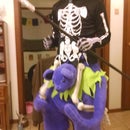Introduction: Fire Poi With Pro Chains the How To's
In this instructable I would like to show you how to make fire poi with the one thing I feel is lacking from most other instructables, and that is pro chains. This is very important if you are planning on performing (Lets be honest if you pull out fire poi people come around to watch THATS PERFORMING even if your just practicing, so safety first) the poi heads are what every one wants to see but every thing else about them is what makes them safer for you and every one else. Also i will go through a few different types of styles of chain, heads, fuel, etc.
Step 1: Picking Your Chain.
This is the part where we discuss chain, this could go on for days if I didn't narrow it down, so I will pick three that I have and have used to discuss the ups and downs. First off we will start with Ball Chain it is the most commonly used chain for poi sold all put together. It is easy to put together, very hard to tangle and for the most part very durable when in larger gauges. In my opinion this is a great option for beginners. Next we will go with the decretive and ornate Chainmail, this is a beautiful but really expensive or time consuming option, I made mine and one chain took me about a week to finish granted I am no pro when it comes to this craft so it took me a little longer than it would most. I have seen them being sold for as much as $500 a set. They are a little more capable of getting tangled, I like this because it will actually lock in to place when doing tricks such as orbitals and hyperloops. Now the one major down fall to these chains is their strength. There are about 1000 individual split rings on each chain and unless you find someone with wayyyyyyyyyyyy to much time on there hands that will weld every one of them, you have 2000 potential places for that chain to bend open and or snap. I love mine but will not use them for any thing but unlit practice. Also you need swivels to use these. Finally my favorite twist chain, this is the chain that they use mostly for dog choker collars and leashes. This will lock up in a orbital nicely it will also slide out of most tangles incredibly easy. Each link is welded closed for superior strength, it resist heat and tarnish from the fire for the most part (I am not saying they do not get hot they do) and it comes in many gauges for your weight preference. These you will also need to have swivels in order for them to not twist up on you. This will be the material that I will be choosing to make my PRO Chains out of.
Step 2: Hardware
Here is what you will need and remember the higher the test the better so long as it fits your application: Split rings get these from a deep sea fishing department ABSOLUTELY NOT the key ring isle try get a 200 lb test or better. You are putting heat and inertia on these connections so even though you may only have a few ounces of weight at the end of your chain several laws of physics apply to make this necessary. BE SAFE NOT SORRY. Swivels also for deep sea fishing use the sealed barrel type they seem to work the best. These are also something you want to get a high test out of, look for around a #2 swivel they have a high test and a very fast spin. D Rings you will need these to be fairly small and welded shut you will be attaching your handles to these so you will get a great deal of pressure at this point in your chain. you will also need some of what ever material you choose to use for your handles ( leather nylon etc.) and your chain you need to figure out the length you would like your chains usually the length of your forearm total. so for 2 chains you will need: 2 lengths of chain, 2 D rings, 4 Swivels, 8 split rings, 2 pieces of fabric of choice for handles
Step 3: Putting It All Together
You will need a flat head screw driver to open the split rings. start by attaching a split ring to a D ring on one side and a swivel on the other these swivel on one side so make them uniform I like to have the spinning side away from the D ring to give me a little more room. Then another split ring to the other side of the swivel attached to the chain. Next at the opposite side of the chain one more split ring connecting to the next swivel. And finally from the opposite side of the swivel a final split ring hooked to the poi head itself. And repeat the process for the other chain. Now going back to the D ring you will sew your handle on to the d ring directly. There are a few styles of handle to choose from so play around and see what you like the best. Check out the pick of the most popular handles, depending on how you hold your poi and the moves you would like to perform all have their advantages. As far as heads go you have soooooooo many styles to choose from all have their ups and downs, really a matter of finding what you like. For instance cathedral heads will take in oxygen well and make a nice even flame and fi they hit you they are not as hard as a lot of others, but they burn fast and the Kevlar will become ragged with time. Monkey fists burn a while longer but they are heavy and hurt to get hit by they will last a long time unless they start to come untied. I could go on for days about heads but that's not my main focus in this instructable so I will refrain from delving too deep into that.
Step 4: Making the Heads (Cathedral Style)
Now I am not in the market for new heads just yet but I will show you how only I will use duct tape for my demo pics as where you will be using 1 1/2 " Kevlar strips. start by cutting your Kevlar to the desired amount (the more you use the longer the burn) around 2 yards per head or more is usually a good starting point. Next find your center point and make a 90 degree fold. Flip the Kevlar over and begin folding it along the flat side, switch off every time until you get close enough to the end as to where you can only make it a little over one and a half ways across. Take this extra Kevlar and tuck it in under the next fold down. If there is not enough fabric to make it past the center of the poi head, make sure you adjust it, or take one layer off so that you can reach. This is so that the center pin makes it through the end tab, ensuring that your poi head does not fray or come apart. Now for the hard part, getting the pin through, Kevlar is a woven fabric, but it is also what bullet proof vests are made of so its not an easy task. Take your folded head and tape it securely to a piece of wood. You can either try to drill through the center or poke a nail though the center. NOTE: your drill bit will never be the same again. Once you manage to get through all the layers make sure you do not take what ever you made it through with out until you are ready to insert the center pin. You will want to do this slowly as to not lose the hole that you made, going one layer at a time will help. make sure that you have a washer on each side to ensure the pin doesn't slip through the hole after the Kevlar starts to ware. That's it your done ready to attach to your chains.
Step 5: Practice
Please Please Please Know you have your tricks down before you try them with fire it really is dangerous and ALWAYS have a spotter with a damp towel and all other safety precautions around when spinning fire. Now go have some fun, be safe, and take care of your fellow man.

Participated in the
Instructables Outdoor Projects Contest













